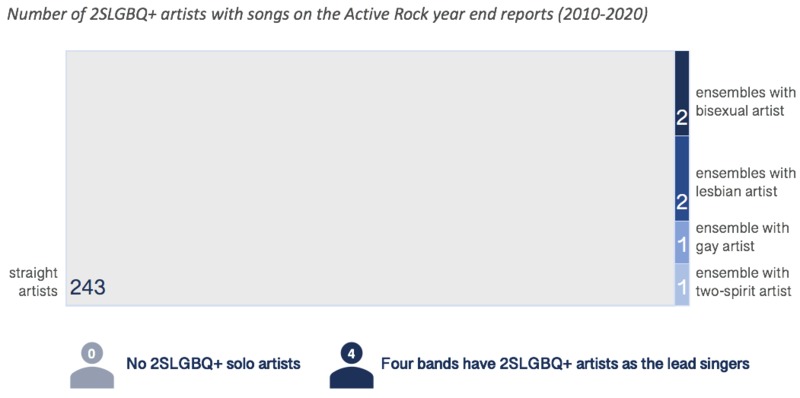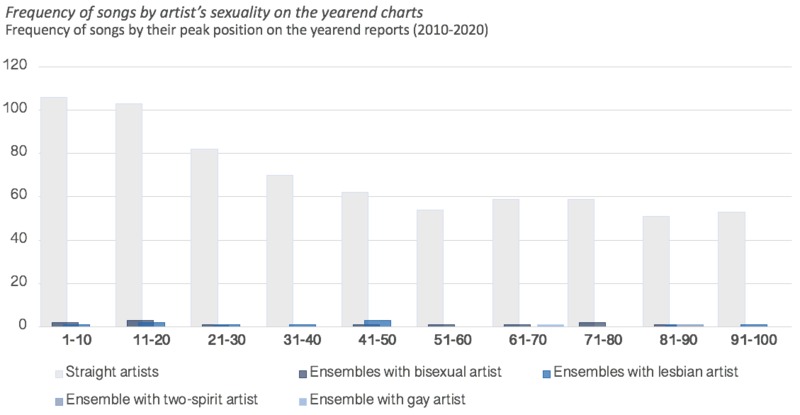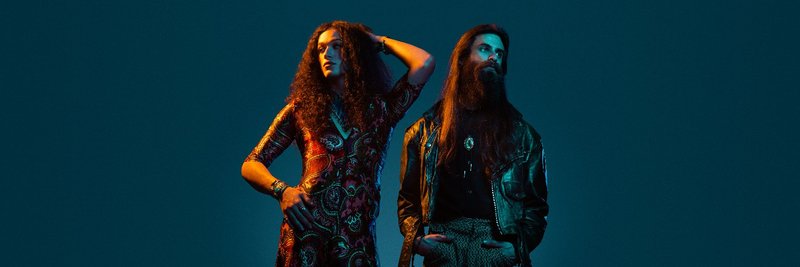2SLGBQ+ Representation
Analysis
2SLGBQ+ ARTISTS: WHEN THEY COME OUT, THEY LEAD THE WAY
Representation of two-spirit, lesbian, gay, bisexual, transgender and queer (2SLGBTQ+) characters in television and film media is increasing every year, and today it is not uncommon to see 2SLGBTQ+ characters in series or movies, even if these characters are portrayed as tokens, stereotypes or the form of a joke (Bond, 2014). On screen there is a growing variety of sexualities represented, however this diversity has not translated to popular music, and particularly not rock radio. As a genre, active rock does not have gender diversity, so queer and transgender artists still have a long way to go until they are represented in this space.
To note, the terms two-spirit, lesbian, gay, bisexual and queer (2SLGBQ+) have and continue to evolve over time. Within this project, we have made the decision to sometimes exclude the T in the acronym, representing the one transgender artist, when that artist’s gender was not applicable to the discussion. For this reason, Laura Jane Grace’s (of Against Me!) gender identity is discussed further under Gender Representation, instead of here in 2SLGBQ+ Representation. This choice makes the analysis less consistent; however, we think it serves as an important reminder that we are discussing people, not just acronyms and data (D’Ignazio and Klein, 2020).
The first graph very clearly demonstrates that the vast majority (97.6%) of active rock artists in the year end reports are straight. While the representation of queer artists is discouraging, there are positive trends, although small. All six 2SLGBQ+ artists are part of an ensemble, but interestingly four of these artists are the lead vocalists. 2SLGBQ+ artists are present in all peak position ranges on the yearend reports but at low numbers. There are three songs that peaked within the top 10 (ranking at 5, 6 and 7), and the highest number of songs (5) fall into the 11-20 range.
In both graphs, artists that were assumed straight and confirmed straight are represented as simply straight. Criado-Perez (2019) has outlined that using the default male is harmful, and similarly, using straightness as the default does not support and celebrate diversity. However, when attempting to lift up voices, we felt confident that if an artist was not public about their sexuality than they could be coded under the straight majority, because they were not openly representing the 2SLGBQ+ community.
Featured Artist
Crown Lands is a Canadian duo made up of Cody Bowles and Kevin Comeau. The Juno-award winning 2021 "Breakthrough Group of the Year" has released one album, and six singles or EPs. Bowles is half Mi’kmaw from Nova Scotia and incorporates Indigenous culture and activism into the band’s music. Bowles is the one two-spirit artist in the dataset. Crown Lands had one song in the Top 100 in 2020, “Leadfoot”, ranked at 84. The band name is a cheeky reclamation of the term “crown land”, that is used to describe land now owned by the government, but stolen from the Indigenous peoples of Canada (Wallock, 2020).



